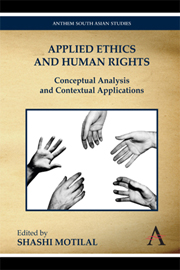Book contents
- Frontmatter
- Contents
- Preface
- Introduction
- Part One Rights, Obligations and Responsibilities
- Part Two Human Rights Issues
- 10 Fragile Identities and Constructed Rights
- 11 Affirmative Action: Compensation or Discrimination?
- 12 Ethics, Human Rights and the LGBT Discourse in India
- 13 Distributive Justice: Locating in Context
- 14 Punishment and Human Rights
- 15 Rights of the ‘Mad’ in Mental Health Sciences
- 16 Choice, Life and the (m)Other: Towards Ethics in/of Abortion
- 17 The Nationalist Project and the Women's Question: A Reading of The Home and the World and Nationalism
- 18 On the Idea of Obligation to Future Generations
- 19 Morality in Cyberspace: Intellectual Property and the Right to Information
- 20 Violence – A Right to the Survival of the Self?
- 21 ‘Moral Obligation’ to Fight for the Prevention of Greater Calamity: A Debate between Sādharana Dharma and Sva Dharma
- 22 Globalisation and Human Rights
- Notes on Contributors
15 - Rights of the ‘Mad’ in Mental Health Sciences
from Part Two - Human Rights Issues
Published online by Cambridge University Press: 05 March 2012
- Frontmatter
- Contents
- Preface
- Introduction
- Part One Rights, Obligations and Responsibilities
- Part Two Human Rights Issues
- 10 Fragile Identities and Constructed Rights
- 11 Affirmative Action: Compensation or Discrimination?
- 12 Ethics, Human Rights and the LGBT Discourse in India
- 13 Distributive Justice: Locating in Context
- 14 Punishment and Human Rights
- 15 Rights of the ‘Mad’ in Mental Health Sciences
- 16 Choice, Life and the (m)Other: Towards Ethics in/of Abortion
- 17 The Nationalist Project and the Women's Question: A Reading of The Home and the World and Nationalism
- 18 On the Idea of Obligation to Future Generations
- 19 Morality in Cyberspace: Intellectual Property and the Right to Information
- 20 Violence – A Right to the Survival of the Self?
- 21 ‘Moral Obligation’ to Fight for the Prevention of Greater Calamity: A Debate between Sādharana Dharma and Sva Dharma
- 22 Globalisation and Human Rights
- Notes on Contributors
Summary
aapnara shudhu monke bandhte jaanen, monke bujhte paren na
(all you psychiatrists know is how to rein in minds; you don't understand the mind)The above is a statement made by a ‘patient’ in a psychiatric hospital. The ‘patient’, whom we cannot name due to a certain code of confidentiality, had been under a long period of treatment in the same psychiatric hospital. Every time the ‘patient’ was called for an interview with the psychiatrist, he came with a small notebook. The notebook contained pages of ‘incoherent’ ramblings from which he would try to read out excerpts (only excerpts) for us. Each time the ‘patient’ made a demonstration of his ‘psychosis’ in an explicit manner, the number and dose of medicines increased. In the subsequent sessions the ‘patient’ appeared more groggy and slurred. But every time the ‘patient’ looked capable of continuing his (broken) dialogue with the psychiatrist … continue the dialogue in the hope of establishing his sanity. Until, finally, somewhat in exasperation the ‘patient’ made the above statement.
What would the psychiatrist do? How would s/he respond to the charge? The doctor-patient relation (here the relation between the ‘psychiatrist’ and the ‘mentally ill’ or the more fashionable ‘mentally challenged’) has been an area of intense debate. The doctor has been described as the expert, godlike or godsend, who bestows health or life. The patient is said to be a layperson, who entrusts faith, belief and the authority in the doctor to make decisions and judgments on his/her behalf.
- Type
- Chapter
- Information
- Applied Ethics and Human RightsConceptual Analysis and Contextual Applications, pp. 193 - 218Publisher: Anthem PressPrint publication year: 2010
- 1
- Cited by



